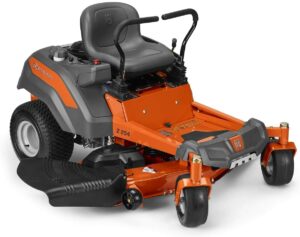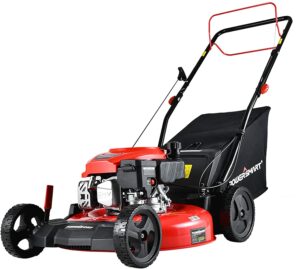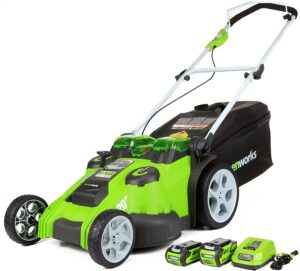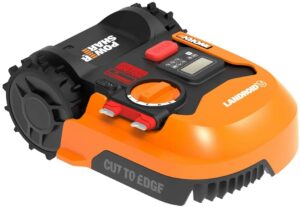Best Lawn Mowers
Best Riding Mower

Best Push Mower

Best Electric Mower

Best Robot Mower

How to choose the right lawn mower
Yard size and terrain
Different lawn mowers serve different purposes, and a crucial part of choosing a lawn mower is choosing one that’s right for your yard size and the terrain of your yard. If your yard has a lot of hills or slopes, a zero turn mower may not be best for you. Additionally, not all mowers are made for cutting unlimited acres of lawn, so first determining what size lawn you need is important before purchasing a new lawn mower.
So, what size do you need? To determine this, divide the deck size of the mower by 12. This will give you an approximate acreage of how much the mower can handle. For example, a mower with a 50-inch deck can mow up to an estimated 4 acres.
Gas vs. electric
Gas mowers
Gas mowers, of course, require gasoline to run. Because they don’t rely on electricity, these mowers typically have a longer run time, meaning you can cut more lawn in less time. Gas mowers are extremely durable and reliable, and they can cut through any type of grass, including long-blade grass and weeds. Gas mowers are also budget-friendly and tend to cost less than electric mowers. The downfall? They’re much noisier (your neighbors won’t appreciate you cutting your lawn at 7 a.m.!), and they require much more maintenance like blade sharpening, tuneups, and oil changes.
Electric mowers
While electric mowers are on the pricier side, there are several benefits. First, not only are they quieter, but they’re sustainable, too! Because they don’t use gas, they produce fewer emissions…a win-win for your lawn and our environment. Not only are they easier to store and maintain than gas mowers, but they are easier to maneuver and operate. The con to purchasing an electric mower is that they don’t last as long—most electric mowers have a battery life of ~30-45 minutes at a time, making them best suited for smaller yards. Additionally, electric lawns aren’t as tough and can’t cut as well on different types of lawns like wet grass, weeds, and more.
Rider vs. push
Rider mowers
Rider mowers are, as their name suggests, mowers that you can sit on and ride around. Riding mowers aren’t created equal—there are actually many different types that serve different purposes:
- Lawn tractor – Lawn tractors often come equipped with a steering wheel and a front-mounted engine (think: a car). These are ideal for cutting large areas of grass, as they can cut 2-3 times faster than regular push mowers. These tractors usually cut more than just lawn, too. Most can tow small carts and can sometimes be converted into snowplows, too! Lawn tractors are also built with comfort in mind, most having cushioned seats and even a cup holder for your water…or beer…we’re not judging. 😉
- Rear engine mower – Rear engine mowers are the perfect balance of a push mower and a lawn tractor. They have more narrow decks, meaning they don’t cut as well (or as much), but they are traditionally cheaper than lawn tractors. The cheaper price tag also means they don’t drive as smooth or come with more upscale features like cruise control.
- Zero turn mower – Zero turn mowers are similar to lawn tractors but instead of controlling them with a sterling, wheel, it’s usually controlled by levers or a lap bar. These can either be gas-powered or battery-powered, and can usually side-discharge, bag and mulch clippings, and more. Zero turn mowers are also easier to maneuver around objects like trees or plants, but because of their low traction, they’re not ideal for properties with a lot of hills or slopes.
Push mowers
Just like electric mowers can be vastly different, so can push mowers! There are a few different varieties of push mowers including front-wheel drive, rear-wheel drive, and all-wheel drive:
- Front-wheel drive mowers: These mowers are great for level lawns with not a lot of hills or slopes. Front-wheel drive mowers are also great for areas with a lot of obstacles like trees, flower beds, or plants, since their wheels are in the front and makes for easier turning.
- Rear-wheel drive mowers: Rear-wheel drive mowers have great traction, making them best for uphill or sidehill mowing. One small drawback to these particular mowers is that they are more difficult to move backwards and change direction.
- All-wheel drive mowers: All-wheel drive mowers are great for mostly all terrains and typically have more traction than even rear-wheel drive mowers. They’re great for steep hills, downhill, sidehills, and everything in between. These are also easy to maneuver, making them perfect for all types of lawns.
Best Riding Mower

This riding mower has a 26 horsepower Kohler engine that provides a max speed of 6.5 MPH! It’s patent-pending park break system activates or deactivates as the steering levers are moved and a flat-stock steel cutting deck makes for maximum durability. This mower also utilizes air induction mowing technology—drawing air from the tom and bottom of the deck to deliver a superior grass-cutting experience. Customers love how easy it is to set up and use!
Best Push Mower

The PowerSmart gas lawn mower has a 4-stroke, single-cylinder gas engine that provides durability and power for cutting the tallest and toughest grass. Its 5 position heigh adjuster lets you determine the height of the grass and its 3-in-1 side discharge and mulching capability allow you to spread grass clippings to the side. Best of all, this mower is lightweight and foldable, making it ideal for smaller storage spaces.
Best Electric Mower

This electric, battery-powered mower is cutting-edge and can adjust for power or runtime based on the thickness of your grass! It’s battery-operated which means its runtime isn’t as long, and its 20-inch cutting deck makes it ideal for mid-sized lawns. Its dual blades provide a high-quality cut and superior mulching.
Best Robot Mower

We have smartphones, smart TVs, smart cars, why not a smart lawn mower? Enter the WORX Landroid robotic mower. This mower is fully automated and can cut up to a quarter of an acre…all by itself—no pushing or riding required. Like all smart items nowadays, it of course comes with an app for your smartphone. This app lets you customize mowing schedules, measure your grass length, and check in on the progress of your mowing. Its patented AIA technology allows this mower to navigate narrow spaces, and it’s smart enough to avoid and back away from any obstacles in its way. If it starts to rain while in use, the Landroid will return to its charging station and resumes once the lawn is dry. What’s smarter than that?
FAQs about Lawn Mowers
What is mulching, bagging, and side-discharging?
These terms refer to what happens to the grass clippings once your mower cuts them. If a mower mulches, the mower cuts the grass down into even finer pieces and recycles it back on the grass to act as a fertilizer. Side-discharging is similar, but it doesn’t cut the grass down finer for fertilization, it simply discharges the grass out of the side of the mower. Bagging is exactly what it sounds like—once the mower cuts the grass, it’s placed into a bag attached to the mower.
How often should I replace my lawn mower?
The answer to this question depends on your lawn mower! A high-quality, durable lawn mower could last many years if well maintained—up to 10 years or more! A few telltale signs that it’s time to purchase a new lawn mower are transmission or engine issues, it breaks down frequently, or you simply want a new one!
What accessories should I purchase for my lawn mower?
From bags and blades to rollers and sweepers, the options for attachments and accessories are endless! For riding mowers, there are many attachments available including tow carts, snow blowers, spreaders, and more. There are fewer accessories available for push mowers, but popular ones include new blades, covers, and bags.
What safety precautions should I use while operating my lawn mower?
Regardless of whether you have a push mower or rider mower, safety precautions should always be taken.
- Be sure to never mow your lawn when it’s raining.
- Always wear proper clothing and shoes.
- Debris can fly when mowing, so make sure other people are not within your mowing area.
- Always read the manual and instructions before operating.
- NEVER let children operate your mower.

